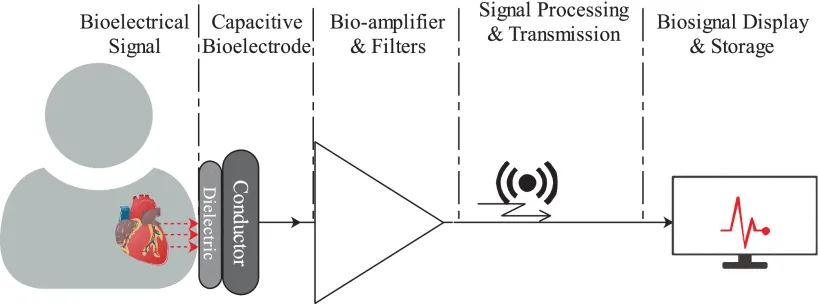Dielectrics for Non-Contact ECG Bioelectrodes: A Review
Cardiovascular diseases are responsible for the lifelong disability of heart patients and are the leading factor of mortality in every demography. In standard practices, the clinical electrocardiogram (ECG) is restricted and dependable for short-term monitoring. With non-contact bioelectrodes, recording ECG for an extended period is feasible, allowing physicians to continuously monitor patients with cardiovascular irregularities and provide immediate aid when necessary. However, due to safety concerns, non-contact bioelectrodes must undergo a rigorous medical assessment before authorized usage.
Non-contact bioelectrodes require dielectric materials that can provide efficient coupling capacitance and stable ECG recording. Dielectrics are vital components for effectively recording ECG without direct skin contact. For over four decades, non-contact bioelectrodes and dielectric materials have been the focus of many research communities. However, researchers are yet to establish a suitable combination of bioelectrode components and dielectrics.
Based on extensive research, the researchers studied the impact and limitation of dielectrics on vital biosensing factors, such as bioelectrode skin interface, coupling capacitance, skin contact impedance, and biosignal processing, which affect capacitive ECG measurement. It was also found that materials’ dielectric properties determined the performance of bioelectrodes. Hence, the selection of materials became an essential factor in non-contact ECG recording applications.
Materials have different dielectric properties and integrity. It is good to use metal oxides for non-contact ECG recording because they have a high dielectric constant. However, problems like possible reactions with sweat, low skin conformity, being prone to motion artifacts, and expensive fabrication need careful consideration. Also, they necessitate the use of shields against electromagnetic interference, front-end amplifier circuits with high input impedance, common-mode ratio, and power consumption.
With remarkable progress in material science, researchers are exploring fabrics and polymers as dielectrics for wearable non-contact bioelectrodes. Fabrics and polymers are flexible, soft, non-toxic to skin, and less expensive, but they have low dielectric constant. Fabrics are porous dielectric materials. When they absorb sweat, the bioelectrode skin interface impedance is reduced, making it more sensitive. However, sweat can change how fabric materials behave in long-term ECG measurements.
Fabric dielectric makes artifact noise when it rubs against the body or bioelectrode conductor during motion, causing friction that creates substantial electrical charges to distort ECG recordings. Therefore, extra support (pressure) to enhance the bioelectrode skin contact is required to reduce artifact noise.
In contrast to metal compounds and fabrics, polymers show exceptional insulative performance. They are, however, non-porous and allow the accumulation of skin exudates. For this reason, they must be fabricated with a low thickness to produce the required coupling capacitance. Likewise, using conductive composites can boost the dielectric constant of polymers.
Each dielectric imposes constraints on fabrication and non-contact ECG recording applications. Therefore, there is a need for review and consideration in line with the intended purpose and bioelectrode design objectives. A possible way is to use composite dielectric materials to address bioelectrode design constraints. Also, low-power consumption micro-electronic devices are now available and can serve as front-end circuits.
Non-contact bioelectrode technology will support long-term ECG monitoring, but it is necessary to prioritize selecting dielectric materials to address existing constraints.




